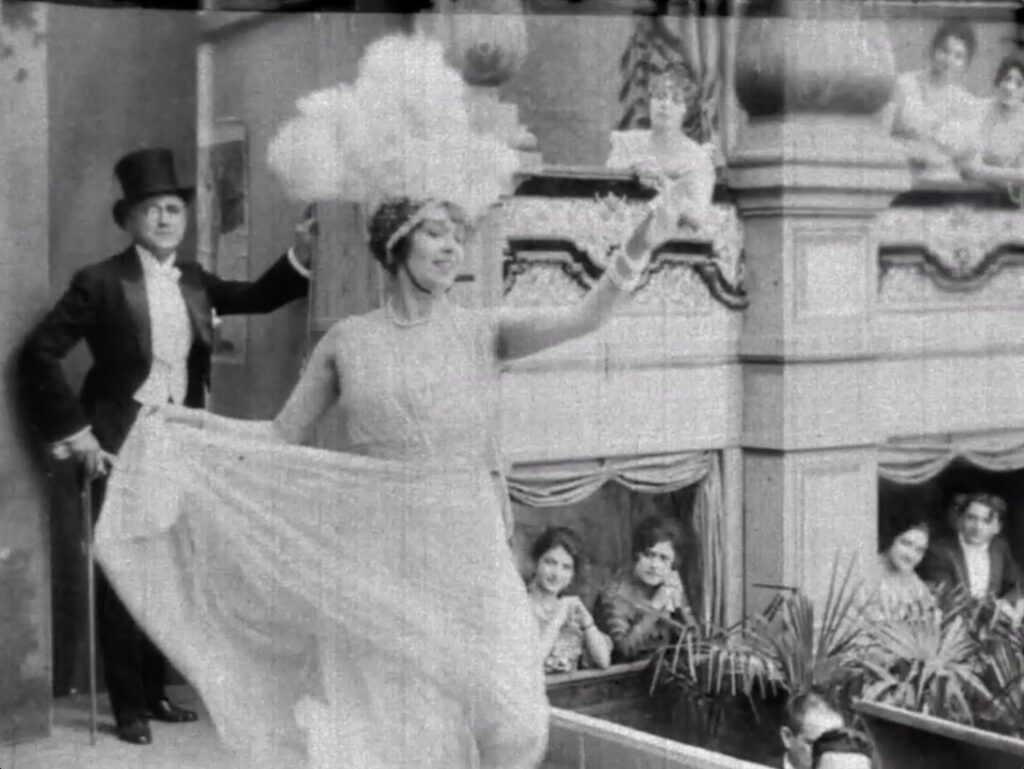Introduction
Until its 2019 website relaunch, the landing page of the Women Film Pioneers Project stated: “Women Film Pioneers Project features silent-era producers, directors, co-directors, scenario writers, scenario editors, camera operators, title writers, editors, costume designers, exhibitors, and more to make the point that [women] were not just actresses (italics in original).” Readers were reminded of the important fact that women’s work in the silent film industry was also behind the camera, work that had been hidden from view, elided, and lost. This article, however, takes the actress–or, rather, what Shelley Stamp terms the “sphere of performative labour”–as its focus.1Shelley Stamp, Lois Weber in Early Hollywood (Berkeley: University of California Press, 2015), 3. My aim is to expose the range of creative and business roles that actresses undertook in early film, and to re-focus our attention onto the actresses whose work we presume to see and understand on screen. I seek to highlight and celebrate the breadth of the actress’s engagement with film, as well as to expose the networks, relationships, and exchanges that were developed between theater and silent film.
As I make clear, my foregrounding of the important and often groundbreaking work of the theatrical actress in early film emerges from collective research and scholarship. Drawing on this scholarship, I bring together and affirm the rich history of the theater actress’s varied and vital work in the nascent film industry. I also draw upon Europe (rather than America) for my case studies. I do this for two reasons: in the first place, a European focus allows me to speak to my own area of expertise, which is the relationship between the late nineteenth-century French actress and early transnational film; secondly, a focus on the European actress allows me to document the significant contributions that actresses from the Old World made to the nascent film industry. The late nineteenth century was, after all, the “golden age” of the actress. It is not surprising that she sallied forth so distinctively and effectively into the opportunities and horizons that film newly afforded.2For information about the importance of the French actress, in particular, during the late nineteenth century, see John Stokes, The French Actress and Her English Audience (Cambridge: Cambridge University Press, 2005), 1, 2, 4-5.
Reconsidering the Relationship Between Theater and Film
The last few of decades of film studies have brought tremendous change to our appreciation of the relationship between stage and screen, theater and film, and live and recorded performance. Those of us schooled in film and media departments in the late twentieth century had the good fortune to be on the cusp of this change, spurred on by teachers, educators, film festival directors, and archivists who challenged us to reconsider the traditional separation between the late nineteenth-century theater and early film history. Scholars and educators such as Heide Schlüpmann, Miriam Hansen, Yuri Tsivian, David Mayer, Eric de Kuyper, Thomas Elsaesser, Christine Gledhill, Linda Williams, Martin Loiperdinger, Charles Musser, André Gaudreault, Janet Staiger, Richard de Cordova, Ben Brewster, and Lea Jacobs (and many others!) prompted us, through their groundbreaking research, to look differently and afresh at the role of performance on screen.3See, for example, Heide Schlüpmann, The Uncanny Gaze: The Drama of Early German Cinema. Trans. Inga Pollmann (Urbana: University of Illinois Press, 2010 [orig. 1990)]. Note that this was originally published in two volumes (the English publication is only the first half of the German edition) as Unheimlichkeit des Blicks: Das Drama des Frühen deutschen Kinos; Yuri Tsivian, Early Cinema in Russia and Its Culture Reception. Trans. Alan Bodger (Chicago and London: University of Chicago Press, 1994) [orig. 1991]); Eric de Kuyper, “Le Théâtre comme ‘mauvais objet.’” Cinémathèque 11 (1997): 63-75; David Mayer, “Learning to See in the Dark.” Nineteenth Century Theatre vol. 25, no. 2 (Winter 1997): 92-114 and “Acting in Silent Cinema: Which Legacy of the Theatre?” In Screen Acting. Eds. Alan Lovell and Peter Krämer (London and New York: Routledge, 1999), 10-30; Christine Gledhill, Reframing British Cinema 1918-1928: Between Restraint and Passion (London: British Film Institute, 2003); Martin Loiperdinger and Uli Jung, eds., Importing Asta Nielsen. The International Film Star in the Making 1910-1914 (New Barnet, UK: John Libbey, 2013); and Ben Brewster and Lea Jacobs, Theatre to Cinema: Stage Pictorialism and the Early Feature Film (Oxford: Oxford University Press, 1997).
Silent film festival directors, archivists, and programmers equally drove and enabled our rapprochement of theater and film. The foresight, advocacy, and sheer hard work of people such as David Robinson and Paolo Cherchi-Usai at Le Giornate del Cinema Muto in Pordenone, Italy, and Gian Luca Farinelli and Mariann Lewinsky at Il Cinema Ritrovato in Bologna, Italy, have provided both a public platform and positive proof of the fecund relationship between stage and screen.4I note, in particular, Paolo Cherchi Usai’s instigation and curatorship of The Griffith Project at Le Giornate del Cinema Muto in Pordenone. This project was organized in 1996 under the joint sponsorship of the Cineteca del Friuli, the British Film Institute, the Library of Congress, New York’s Museum of Modern Art, and the George Eastman House (now the George Eastman Museum). See Paolo Cherchi Usai, general editor, The Griffith Project. Volumes 1-12 (London: British Film Institute, 1999-2008). Note also the brilliant advocacy and programming work of Mariann Lewinsky at Il Cinema Ritrovato, Bologna. See the program archives, available at: https://festival.ilcinemaritrovato.it/en/edizioni-precedenti/ (accessed August 8, 2022). The recent work of Julie Allen, Ivo Blom, Jon Burrows, Annette Förster, Hilary Hallett, Elena Mosconi, Matthew Solomon, and many others (including myself) evidences the profound impact that this generation has exerted in film studies.5See, for example, Annette Förster, Women in the Silent Cinema: Histories of Fame and Fate (Amsterdam: Amsterdam University Press, 2016); Hilary Hallett, Go West, Young Women!: The Rise of Early Hollywood (Berkeley: University of California Press, 2013); Jon Burrows, Legitimate Cinema: Theatre Stars in Silent British Films, 1908-1918 (Exeter: University of Exeter Press, 2003); Victoria Duckett, Seeing Sarah Bernhardt: Performance and Silent Screen (Urbana: Illinois University Press, 2015); and Julie K. Allen, “Divas down under: the circulation of Asta Nielsen’s and Francesca Bertini’s films in Australian cinemas in the 1910s.” Studies in Australasian Cinema vol. 11, no. 2 (2017): 59-76 and Screening Europe in Australasia: Transnational Silent Film Before and After the Rise of Hollywood (Exeter: University of Exeter Press, 2022). Likewise, the generative relationship between the theatrical actress and early film is today developed and enriched by a new generation of festival directors, programmers, and archivists. Among this contemporary group must be acknowledged the ongoing advocacy and work of Jay Weissberg (director of Le Giornate del Cinema Muto), Bryony Dixon (British Film Institute), Elif Rongen-Kaynakçi (EYE Filmmuseum), and Vanessa Toulmin (National Fairground Archive, University of Sheffield). Finally, those of us who attend film festivals with live musical accompaniment unfailingly attest that the work of the actress on screen is also supported, enriched, and even made visible by the deft professional work of brilliant musicians such as, but not limited to: Neil Brand, Maud Nelissen, John Sweeney, Donald Sosin, and Mauro Colombis.
Our reconsideration of the relationship between the late nineteenth-century theater and early twentieth-century film is a vital and ongoing task. Significantly, the return to a more inclusive, theatrically-informed early film history often demands the identification of–and access to–films that are often either overlooked, elided, or lost in traditional film histories. The return to a theater/film nexus also demands a consideration of the galvanizing contribution that the stage actress brought to entertainment industries more broadly in the nineteenth and early twentieth centuries. Important research by theater historians has demonstrated that the theatrical achievements of the late nineteenth-century actress have been obfuscated, silenced, replaced, or occluded by male endeavors. As Jacky Bratton contends in The Making of the West End Stage: Marriage, Management and the Mapping of Gender in London, 1830-1870 (2011), women were not only performers on stage but also artistic directors and theater managers; they were implicated in all forms of creative entrepreneurship in London’s West End during the mid to late nineteenth century.6Jacky Bratton, The Making of the West End Stage: Marriage, Management and the Mapping of Gender in London, 1830-1870 (Cambridge: Cambridge University Press, 2011). Bratton explains that a new and more nuanced understanding of women’s role in helping to legitimize both leisure and pleasure in Victorian Britain can help us appreciate women’s agency in theater history.
The scholarship of theater historians such Katherine Newey, Kerry Powell, Maggie B. Gale, Viv Gardner, and John Stokes supports this point, underscoring the central role of the actress in the late nineteenth century.7See, for example, Katherine Newey, Women’s Theatre Writing in Victorian Britain (Hampshire & New York: Palgrave Macmillan, 2005); Kerry Powell, Women and Victorian Theatre (Cambridge: Cambridge University Press, 1998); Maggie B. Gale and Viv Gardner, New Histories, New Historiographies: Women, Theatre, and Performance (Manchester: Manchester University Press, 2000); and John Stokes and Maggie B. Gale, The Cambridge Companion to the Actress (Cambridge: Cambridge University Press, 2007). As Stokes argues in The French Actress and her English Audience (2005), the late nineteenth century was dominated by renowned female performers who ushered in a “golden age of acting.”8Stokes, The French Actress, 1, 2, 4-5. In Maggie B. Gale and Stokes’ collection, The Cambridge Companion to the Actress (2007), this discussion of transnational celebrity actresses slides into early film. Hence, in David Mayer’s contribution to the volume, “The actress as photographic icon: from early photography to early film,” the actress provides the conceptual and commercial focus for a study linking female stage renown to the technological diffusion of celebrity. The commercial reproduction of the photograph and film could, as Mayer explains, enhance a theater actress’s renown “to all parts of the country, and beyond, to the Empire.”9David Mayer, “The actress as photographic icon: from early photography to early film,” op. cit. 74. The Cambridge Companion to the Actress also includes Christine Gledhill’s article, “The screen actress from silence to sound.” As Gledhill demonstrates, just as screen acting offered different opportunities to the legitimate player and “the modern girl,” so too was the transnational circulation of her image differently inflected into local conditions.10Christine Gledhill, “The screen actress from silence to sound, ” ibid. 193-214.
This breakdown in the divide between theater and film history also emerges from an increase in scholarly work on melodrama. Melodrama–a sensational, spectacular, and sometimes even excessive mode of expressiveness that was fully available to the early cinema–demands a consideration of the links and crossovers between theatrical forms and performance practices. The most recent exemplification of this consideration can be found in Christine Gledhill and Linda Williams’s co-edited collection, Melodrama Unbound: Across History, Media and National Cultures (2018). As Gledhill explains in the prologue of this substantial and important collection, melodrama is “a cross-generic modality that…infuses mainstream media fictions.” Rather than being assigned, therefore, to a specific period of theatre history or considered a feminized genre of mid twentieth-century film (“the weepies”), melodrama is instead propounded as a genre-generating machine. Its central function is “its recognition of the personalized virtues and vices of characters whose actions have consequences for others.”11Christine Gledhill and Linda Williams, eds. Melodrama Unbound: Across History, Media, and National Cultures (New York: Columbia University Press, 2018), 5.
The capacity of melodrama to be unpacked in this way, through a consideration of its centrifugal richness, has had profound consequences for the consideration of the actress’s significance to film history. As David Mayer and Helen Day-Mayer demonstrate in Melodrama Unbound, sensitivity to physical expression and an awareness of the articulate role of music enables us to appreciate gestural nuance in silent film acting.12David Mayer and Helen Day-Mayer, “Performing/Acting Melodrama,” ibid. 99-113. The contribution by Hilary Hallett, entitled “Melodrama and the Making of Hollywood,” highlights the modernity of melodrama. As Hallett argues, melodrama helped fuel the birth of Hollywood precisely because it gave agency to women both on and off the screen.13Hilary Hallett, “Melodrama and the Making of Hollywood,” ibid., 115-134. In an important development for the ongoing task of rethinking the relationship between stage and screen, Melodrama Unbound also includes a consideration of melodrama in Japanese, Chinese, Indian, and Latin American contexts. Such a transnational analysis opens the nexus between theater and film to further cultural encounters and hybrid forms.
The idea that the popular theater was a potent platform for feminist opportunity has been embraced by cultural studies more generally. In Female Spectacle: The Theatrical Roots of Modern Feminism (2000), Susan A. Glenn argues that in America between the late 1880s and the late 1920s, actresses on the popular stage were a proto-feminist vanguard “helping to define the modern social and sexual terrain.” 14Susan A. Glenn, Female Spectacle: The Theatrical Roots of Modern Feminism (Cambridge, MA: Harvard University Press, 2000), 3. While Glenn does not consider acting in silent film (and seems genuinely oblivious to the fact that an irreverent female spirit can be found in films produced before the 1930s), she nevertheless makes the theatrical actress the centerpiece in her discussion of modern feminism. In this way, we are reminded that the actress was a flashpoint for social protest, progressive politics, and cultural change.
Glenn’s elision of the silent screen actress illustrates a central argument made in the opening pages of Jane Gaines’ book, Pink-Slipped: What Happened to Women in the Silent Film Industries? (2018). As Gaines explains, the screen actress has been “lost in plain sight.” 15Jane M. Gaines, Pink-Slipped: What Happened to Women in the Silent Film Industries? (Urbana: University of Illinois Press, 2018), 11. Taking the early American stunt actress Pearl White as her example, Gaines argues that one celebrity actress can obfuscate and incarnate the stage and screen work of earlier, forgotten actresses. Gaines contends that the silent film actress consequently is at once visible yet invisible. She is lost in film history (because we know little about screen actresses) yet, once seen and acknowledged, she nevertheless presents a loss (of the other actresses and performers who, as Gaines argues, preceded and “underwrote” her). My discussion will therefore shift backward, away from Pearl White, into a consideration of the renowned stage actresses who “underwrote” her when they transitioned into silent film. In the opening decade of the twentieth century, actresses such as Asta Nielsen, Eleanora Duse, and Sarah Bernhardt forayed into the cinema as mature performers, their celebrity well established before they engaged with film. Younger performers such as the music hall actress Mistinguett also built their celebrity on film while they amassed audiences in popular theaters. As I explain in the next section, the subsequent removal of these actresses from film history–that is, one of the reasons why it has taken roughly a century to celebrate the stage actress’s perspicuous entrepreneurship and cultural significance to the nascent cinema–can be linked to the circumstances of film’s emergence as a discipline within the university.
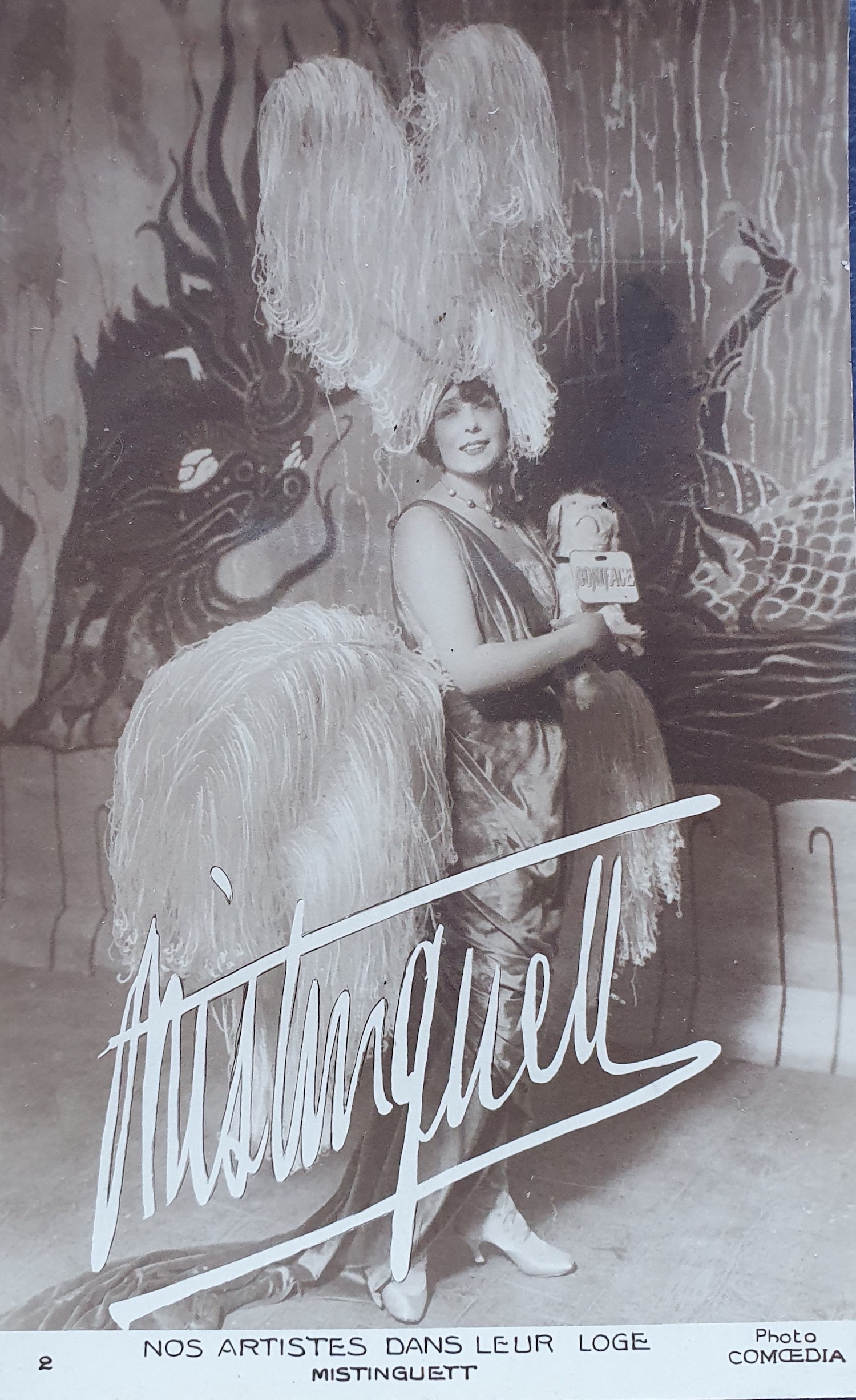
Undated Mistinguett postcard. Laurence Senelick Collection.
Defining a Discipline: The Emergence of Film Studies
Film history has a complex and changing relationship with theater history. The relationship between the two fields was determined by the complexities of film’s emergence and integration into the arena of arts practice and criticism (including theater practices, media practices, and popular performance practices). From the opening decades of the twentieth century, there were continuing debates about film from a wide range of cultural, industrial, and critical activists, both hostile and celebratory.16See Annette Kuhn and Guy Westwell’s discussion of “film studies” in A Dictionary of Film Studies (Oxford: Oxford University Press, 2020). See also, Lee Grieveson and Haidee Wasson, “The Academy and Motion Pictures.” In Inventing Film Studies, eds. Lee Grieveson and Haidee Wasson (Durham: Duke University Press, 2008), xi–xxxii. As Lee Grieveson and Haidee Wasson explain in their 2008 essay “The Academy and Motion Pictures,” the fragmented nature of film studies as a discipline reflects its “diffuse interests, diverse political orientations, and changing intellectual formations.”17Grieveson and Wasson, “The Academy,” xxix. Historically, this diffusion and diversity was evidenced in the exploration and contestation of what film represented, and what its relation to theater was or should be. Debate was necessarily contextual, and tied to the specific and located conditions of a given institution and/or cultural industry. Arising from these widespread debates, expressed through popular opinion and critical judgement, there later arose a division between theater and film historians.18I thank Christine Gledhill for her generous direction, support, and articulation of these points in her review of this overview essay.
Each author, critic, historian, and/or activist was arguing for stakes that were intertwined with possibilities for government funding, educational recognition, and/or institutional acceptability. Early film critics like Vachel Lindsay, writing The Art of the Moving Picture in the early teens, spoke of Sarah Bernhardt in Camille (La Dame aux Camélias, André Calmettes and Henri Pouctal, 1911) as “a tintype,” and stated that she was “[t]he prime example of complete failure” on screen.19Vachel Lindsay, The Art of the Moving Picture (New York: Macmillan Co., 1915 [rev. ed., 1922]), 157. Available at: https://archive.org/details/cu31924074466933/page/n203/mode/2up/search/Camille. Film failure, in Lindsay’s view, was explained by the fact that Bernhardt’s film “might be compared to watching Camille from the top gallery through smoked glass, with ones ears stopped with cotton.”20Ibid., 108. Hugo Münsterberg, writing two years later (in 1917), also separated stage from screen. Münsterberg argued that “With the rise of the moving picture has come an entirely new independent new art which must develop its own life conditions…the shortcomings of one as against the other reflect only the fact that the one has a history of fifteen years while the other has one of five thousand years.”21 Hugo Munsterberg, The Photoplay: A Psychological Study (New York and London: D. Appleton and Company, 1916), 141. Available at: https://archive.org/details/in.ernet.dli.2015.82037/page/n149/mode/2up. Erwin Panofsky, publishing one of the most famous and influential articles on film aesthetics in 1936 (later republished as “Style and Medium in the Motion Pictures,” in 1947) contended that it was “a significant fact” that the great actors of the silent period did not come from the legitimate stage.22Erwin Panofsky, “Style and Medium in the Motion Pictures.” Bulletin of the Department of Art and Archaeology, Princeton University, 1934; Reprinted in Angela Dalle Vacche, The Visual Turn: Classical Film Theory and Art History (New Brunswick, New Jersey and London: Rutgers University Press, 2003), 79.
Nicholas Vardac’s 1949 study Stage to Screen: Theatrical Method from Garrick to Griffith was particularly damning in its consideration of a separation between the late nineteenth-century theater and early film. Concluding his treatise, Vardac argued that the cinema did “so much better the selfsame things which had been the aim and objective of the nineteenth century theatre.”23A. Nicholas Vardac, Stage to Screen: Theatrical Method from Garrick to Griffith (Cambridge, MA: Cambridge University Press, 1949), 251. Available at: https://archive.org/details/in.ernet.dli.2015.60521/page/n325/mode/2up. Roughly half a century later, when early film history first entered graduate school curricula in the United States in the mid 1990s, books such as Eileen Bowser’s The Transformation of Cinema, 1907-1915 (1994) brought new insights and nuances to our understanding of the development of early film, and highlighted the tremendous changes that occurred within the industry in a very short period of time. Scholarly attention like Bowser’s to filmmaking processes, as well as to exhibition and reception contexts, helped to contextualize the emergence of stabilized production and distribution systems.24Eileen Bowser, The Transformation of Cinema, 1907-1915 (Berkeley: University of California Press, 1994). However, notwithstanding a reconsideration of film history, the stage actress–and particularly the European stage actress–was still seen to incarnate the stylized performance of the legitimate theater. Her acting style, seen in contrast to what Bowser called naturalistic, “modern film acting,” remained positioned as an anachronism in the otherwise developing field of film studies.25Ibid., 92.
While decades of scholarship can be mined for these different (but effectively quite similar) divisions between stage and screen, we must recall that educated film enthusiasts were at the time of cinema’s systemization (in the 1920s and 1930s) struggling to have film recognized as a separate and unique art form. The Close Up critics in the United Kingdom, as well as those that followed them, sought to have film distinct from, not an adjunct to, theater and the other arts (such as sculpture, painting, and music).26See Richard Lowell MacDonald, The Appreciation of Film: The Post-war Film Society Movement and Film Culture in Britain (Exeter: The University of Exeter Press, 2016). See also Laura Marcus, “Cinema and Visual Culture: Close-Up (1927-33).” In The Oxford Critical and Cultural History of Modernist Magazines, eds. Peter Brooker and Andrew Thacker. Vol. 1, Britain and Ireland; and James Donald, Anne Friedberg, and Laura Marcus, eds., Close Up, 1927-1933: Cinema and Modernism (Princeton, NJ: Princeton University Press, 1998). I thank Christine Gledhill again for her helpful comments which clarified these points for me. This aim to have film recognized as an identifiable field of academic study–that is, as a discipline separate from English, Theater Studies, and Art History–became even more important for getting film into higher education in the 1950s, 1960s, and 1970s. The hurdles faced by advocates for Film Studies included the claim of film on publishers’ finances, art gallery and educational budgets, and curriculum spaces. For film practitioners, producers, makers, actors and actresses, and writers, the advent of the cinema meant new resources, new openings, and a myriad possibilities of specializations and combinations.
In sum, the critical complexities of cinema’s emergence and integration into the arena of arts practice and criticism fueled the foundation of Film Studies, just as it established a complex division between theater and film historians. As I have already shown, only in the last thirty or forty years has the division between stage and screen been redressed, whittled down, and positively re-conceived. David Mayer explains that the relationship between the late-Victorian and Edwardian stage and early film can today been seen as “a fluid period of explorations and experimentations, developments, borrowings, and mutual rip-offs.”27David Mayer, Stagestruck Filmmaker: D.W. Griffith and the American Theatre (Iowa City: University of Iowa Press, 2009), 27, 29. See also the articles in Kaveh Askari et al, Performing New Media 1890-1915 (New Barnet: John Libbey, 2014), particularly Gwendolyn Waltz, “20 Minutes or Less: Short-Form Film-and-Theatre Hybrids- Skits, Sketches, Playlets, & Acts in Vaudeville, Variety, Revues, &c,” pp. 245-253. With screen practices incorporated into performance pieces and theater shows today, we also see contemporary evidence of the richness of these overlaps and interweavings.28A particularly strong example of this can be seen in the recent staging of “The Picture of Dorian Gray” by Eryn Jean Norvill (adapted and directed by Kip Williams) where video, screens, and live performance merge and intersect on stage. See https://rising.melbourne/festival-program/the-picture-of-dorian-gray for images of this (accessed August 8, 2022).
Finding Feminisms: The Actress’s Work in Front of and Behind the Camera
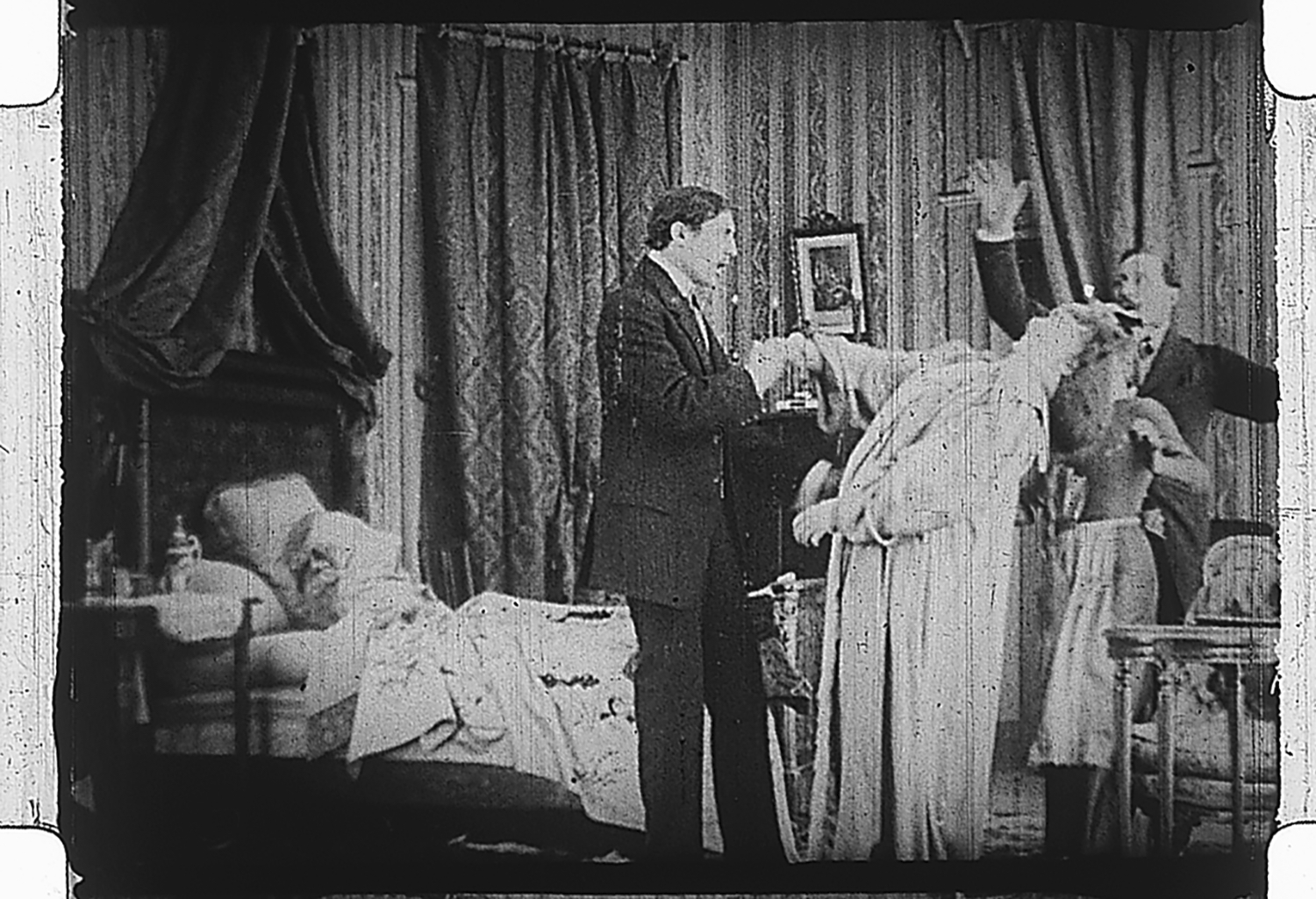
Frame enlargement. Bernhardt spirals to her death in Camille (1911). Courtesy of the National Film and Sound Archive of Australia.
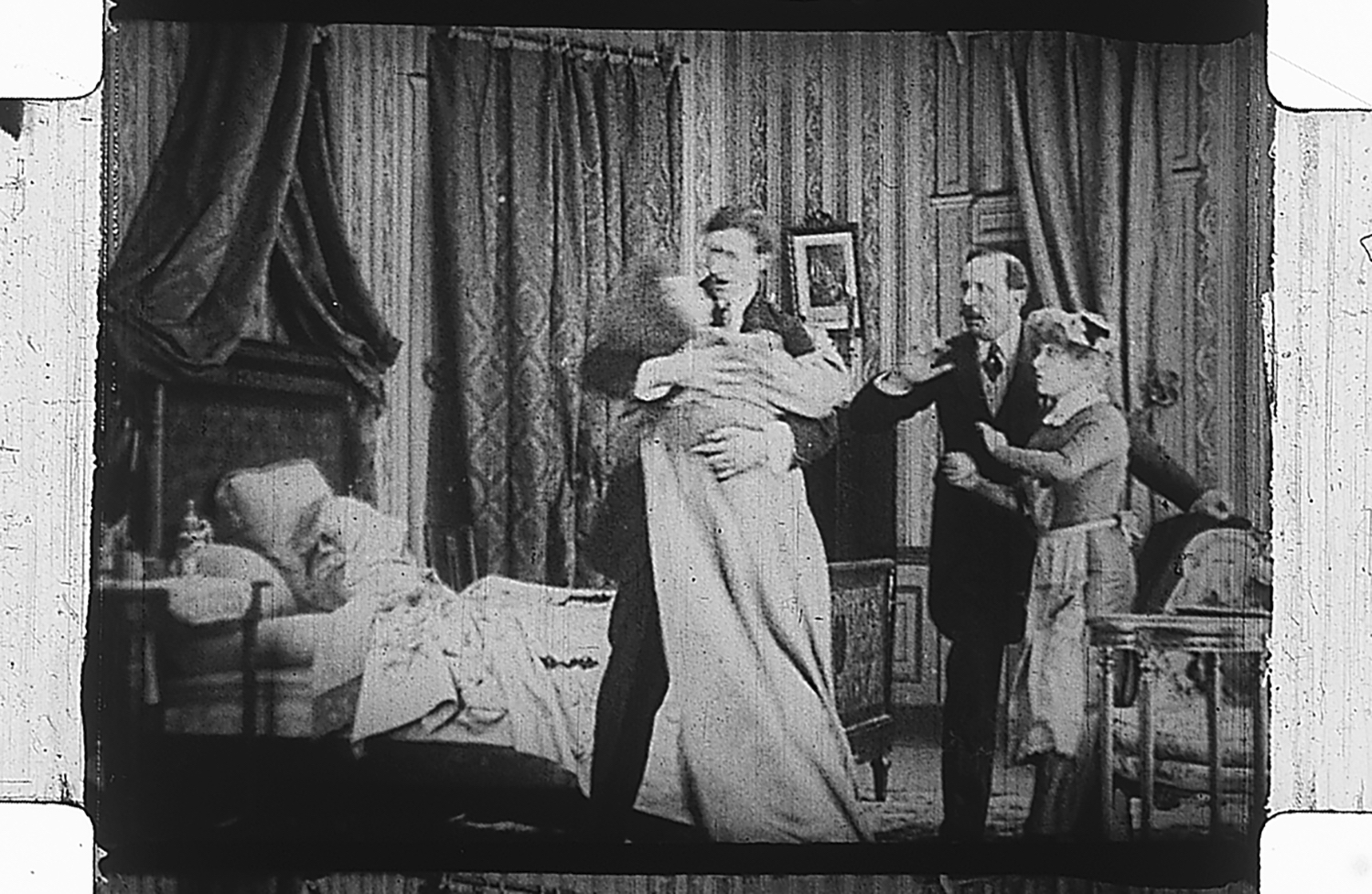
Frame enlargement. Bernhardt spirals to her death in Camille (1911). Courtesy of the National Film and Sound Archive of Australia.
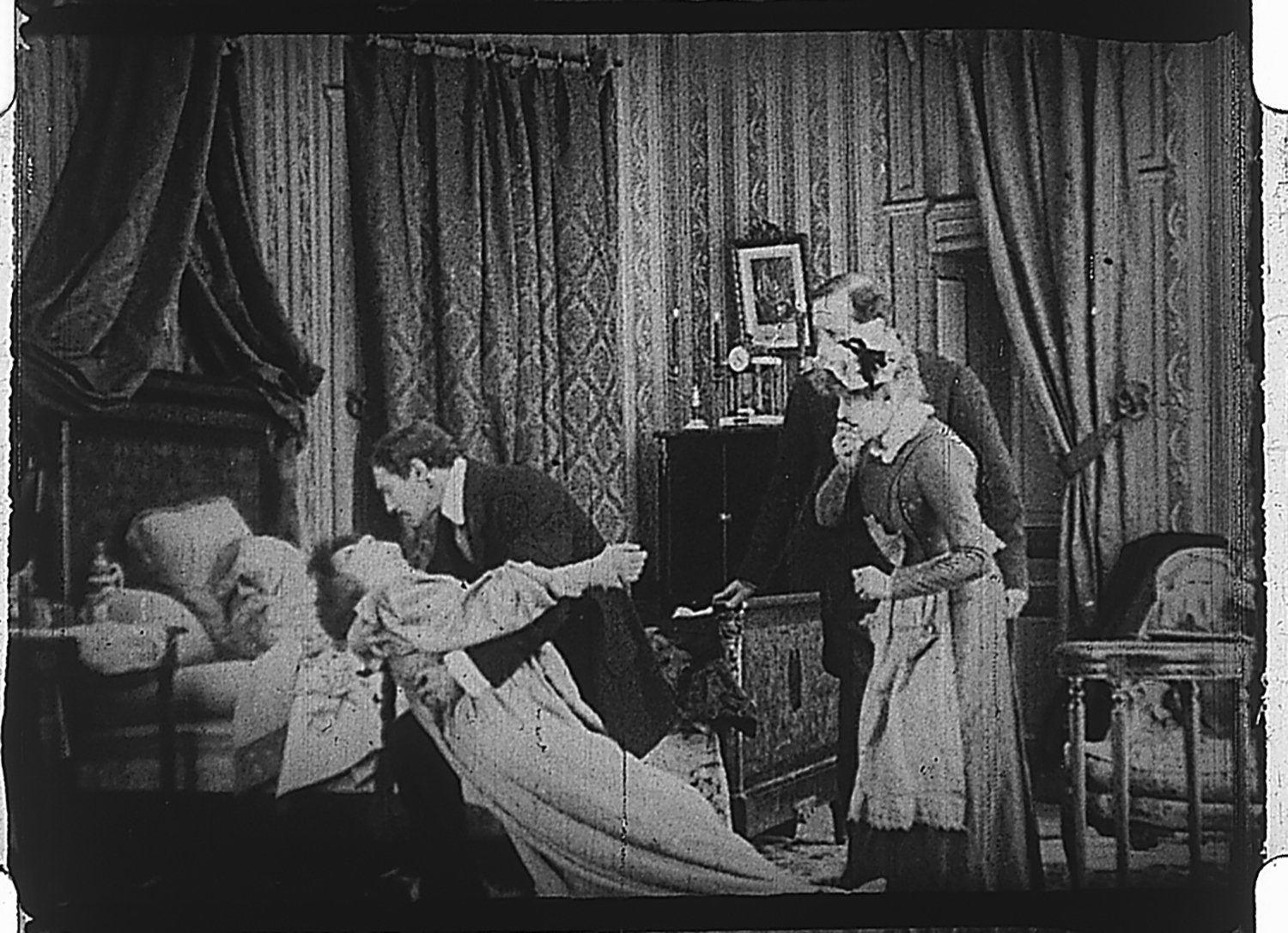
Frame enlargement. Bernhardt spirals to her death in Camille (1911). Courtesy of the National Film and Sound Archive of Australia.
A significant strand of recent scholarship has involved the act of uncovering women lost to us in the film archives. The identification of hitherto overlooked or unknown female directors, editors, writers, projectionists, film critics (and so on) demonstrates that women were implicated and active within all aspects of the moving picture industry. This process of identifying and contextualizing women as makers behind the camera (that is, away from the public gaze) is important because it foregrounds females as agents in technological and industrial change, while contesting traditional gendered divisions of labor. The stage actress, working in front of the camera, equally levels challenges to traditional understandings of early film. Actresses such as Sarah Bernhardt, Gabrielle Réjane, and Lyda Borelli not only performed on film; they adapted their renowned stage plays in their own idiosyncratic ways to the demands of the new medium. These actresses modified the length of their plays, often eliminating entire acts so that audiences were presented with a familiar but very changed works. The tempo and range of their gestures were similarly adapted to the changed spatial and temporal affordances of film. Actresses also chose key moments or sequences of physical expression to relay narrative and emotional meaning. For example, in Camille, a film that drew upon over thirty years of Bernhardt’s global fame as Marguerite in “La Dame aux Camélias” on the live stage, Bernhardt swivels to her death at the end of the film. Her body is caught by her lover while she spirals her descent to the ground. In this brief action, we see her white nightdress (so familiar as a costume for women on the nineteenth-century stage) wrap itself one final time around her thin and falling body. We also see Bernhardt’s final tendrilic turn, and hence the actress’s capacity to incarnate art nouveau on film. Through film, the theater thus emerges as a modern art form whose unique and expressive physical phrases of action are now made available to popular audiences.
The late nineteenth-century stage actress was a highly respected and creative individual performer; her career was built upon the differentiation between her own performance and that of another actress. Hence, when Bernhardt first introduced this standing, tendrilic death to “La Dame aux Camélias” on stage, critics paid attention to her “curious novelty” because it changed the traditional representation of Marguerite expiring on a bed, or stretched on a chaise lounge.29“The French Plays.” The Times (13 June 1881): 13. In this context, it is important to appreciate that Bernhardt–as well as her renowned peers on the stage, such as Lyda Borelli, Eleanora Duse, and Asta Nielsen–did not follow instructions but instead chose her roles, authored her own performance style, selected costumes, and provided her own sets and props. Moreover, celebrated actresses such as Bernhardt and Réjane were managers and directors of their own theaters in Paris (the eponymous Théâtre Sarah Bernhardt and the Théatre Réjane).30As Jane Gaines reminded me in her review of this overview essay, there is no easy equivalent to a figure like Bernhardt in the United States, particularly in the context of a stage actress who transitioned to motion pictures. Bernhardt’s transnational reach into America enabled her to become localized and shared in new contexts and ways. See my forthcoming Transnational Trailblazers: Sarah Bernhardt, Gabrielle Réjane, Mistinguett (Berkeley: University of California Press, 2023). As Bernhardt’s feature film, Queen Elizabeth (Les Amours de la Reine Élisabeth, Louis Mercanton and Henri Desfontaines, 1912), announces: “Dresses, Armor and Furniture from the Sarah Bernhardt Theatre, Paris.”31See Gerda Taranow, Sarah Bernhardt: The Art Within the Legend (Princeton, NJ: Princeton University Press, 1972) who speaks of how “Photographs and film reveal the magnificence of the acclaimed mise en scène” (168). The actors that performed on film were also those who were in Bernhardt’s original theatrical productions and who worked at the Théâtre Sarah Bernhardt.32 Note that although the film gives credit for Mlle Romain, she is sometimes cited as “Romani.” See Bert’s photograph in (screen 1), “La reine Elisabeth,” pièce d’Emile Moreau: documents iconographiques, 1912, available at https://gallica.bnf.fr/ark:/12148/btv1b84387335.item (accessed August 8, 2022). See also the credits of the film given by the CNC at http://lise.cnc.fr/Internet/ARemplir/Parcours/100ans/juillet1913.html (accessed August 8, 2022). Moreover, other theatrical practices–time set aside for rehearsals and a separate rehearsal room to explore scenes away from the set–were associated with the work of the theatrical actress moving into early film.33For example, discussion by The Moving Picture World, in relation to Bernhardt’s Camille, indicates that rehearsal practices were continued when the actress moved to film. We are told that “’Camille’ was rehearsed a few times with the watch in order to get it timed right…” See “Bernhardt conquers new world.” The Moving Picture World (9 March 1912): 874-875. Further, actresses who worked in the theater insisted that actors be allowed rehearsal time and an actual–separate–rehearsal space where a scene could be explored away from the set. An actress who should be credited with this is Blanche Sweet who, circa 1910-11, persuaded Griffith and Biograph that rehearsals were needed and that Biograph studio needed a separate rehearsal room. See Martin Sopocy, “Behind the Scenes: An Interview with Blanche Sweet.” Griffithiana, La Rivista della Cineteca del Friuli no. 71 (2001): 111- 123, especially 117-118. See also Karen Ward Mahar’s Women Filmmakers in Early Hollywood (Baltimore: Johns Hopkins University Press, 2006), particularly Chapter 2. A recent special issue of Nineteenth Century Theatre and Film that I co-edited with Vito Adriaensens, “The Actress-Manager and Early Film,” draws attention to the figure of the actress-manager and her transition to early film, presenting research into well-known actresses such as Bernhardt, Duse, Betty Nansen, and Marion Davies, as well as the little-known figures of Mrs. Kate King, Mrs. Almena Garrett, Mrs. Frances Latimer, Miss Marie Clegg, and Helena Cortesina.34Victoria Duckett and Vito Adriaensens, eds. “The Actress-manager and Early film.” Nineteenth Century Theatre and Film vol. 45, no. 1 (September 2018).
The agency that the late nineteenth-century actress enjoyed “behind” the camera also included the significant work she undertook in the development of collective, institutional networks. The Danish actress Asta Nielsen provides a good example of the actress’s capacity to operationally engage the film industry to serve her own business needs. Unlike Bernhardt and Réjane, Nielsen was not a major celebrity actress before she entered the silent film industry. It was through her inaugural film, The Abyss (Afgrunden, Urban Gad, 1910), that Nielsen gained international fame, particularly within Europe. Nielsen went on to make over seventy films, mostly within Germany and with German film production companies. While her acting on film was popular with audiences, recent scholarship has highlighted other, productive ways of thinking of Nielsen’s contribution to early film. Prime among these is Nielsen’s status as a global film star circulating in a new, monopoly distribution system. Indeed, within a year of gaining fame on film, Nielsen negotiated a deal with the distribution company, Internationale Film-Vertriebs-GmBH. As Julie Allen explains in her WFPP career profile of Nielsen, in return for the distribution rights to thirty-two Nielsen films, Nielsen gained a generous salary and revenue from her films as well as “full artistic freedom in choosing her screenplays, costumes, and supporting actors, and, perhaps more importantly, the right to be directed exclusively by her soon-to-be husband [Urban] Gad.” These conditions were gained in 1911 and come on the heels, I contend, of celebrities like Bernhardt and Réjane entering the entertainment industry as both actresses and managers in the live theater.35Julie Allen, “Asta Nielsen.” In Women Film Pioneers Project. Eds. Jane Gaines, Radha Vatsal, and Monica Dall’Asta. New York, NY: Columbia University Libraries, 2017. https://doi.org/10.7916/d8-dw7e-x721. I would like to thank Christine Gledhill, in review of my work, for highlighting the fact that the feminist division between women “in front of” or “behind” the camera has occluded knowledge that the actress brought to the development of film.
The changes Nielsen introduced to film practice in the silent period were important.36 I thank Jane Gaines for reminding me that Nielsen was exceptional among European women in negotiating the PAGU contract, but lost out later. See discussion also in Schlüpmann, The Uncanny Gaze. As Annette Förster explains, Nielsen’s monopoly distribution system was adopted by the German actress, film director, and screenwriter Rosa Porten and her husband, Franz Eckstein, when they were affiliated with an independent production company (the Treumann-Larsen Filmvertriebs-GmbH) between 1913 and 1922. Using the pseudonym Dr. R. Portegg, Porten marketed her own films as “Rosa Porten Serie.” Porten marketed, to similar effect, the films of Wanda Treumann, labeling them the “Wanda Treumann Serie.” Moreover, Porten collaborated with Nielsen on the script for Hedda Gabler (1924) and Die Schmetterlingsschlacht (1924).37Annette Förster, “Rosa Porten.” In Women Film Pioneers Project. Eds. Jane Gaines, Radha Vatsal, and Monica Dall’Asta. New York, NY: Columbia University Libraries, 2016. https://doi.org/10.7916/d8-q5qw-0p84. Porten highlights the actress’s capacity to strategize as a performer, writer, and business manager in the film industry, as well as the collaborative nature of the actress’s work on screen. Instead of working under the thumb of a given director, and instead of engaging with other actresses in an adversarial manner, Nielsen and Porten demonstrate the range of skills as well as the professional bonds and networks that enabled actresses to succeed in the film industry.
In her recent book, Women in the Silent Cinema: Histories of Fame and Fate (2017), Förster develops her argument about the range and depth of professional engagements that actresses enjoyed in the entertainment industries during the late nineteenth and early twentieth centuries. Explaining that actresses enjoyed a “careerography,” Förster develops our understanding of who an actress was and what she could achieve in the nascent film industry. Taking three different but related case studies, Förster examines the careers of the Dutch actress Adriënne Solser, the French actress Musidora, and the Canadian actress Nell Shipman. Förster demonstrates that these actresses learned “their metier in practice” before acting in, producing, and directing film (and in the case of these three, by establishing production companies).38Förster, Women in the Silent Cinema, 10. A shift from the live stage to film did not mean that the live stage was relinquished and abandoned. Rather, the actress enjoyed a careerography that moved between art forms (the theater, film, and writing). This was not a hierarchical career, where a teleological endpoint was the achievement of film. Indeed, Förster is very clear when she states that the actress’s professional and creative flexibility did not “necessarily privilege cinema over other disciplines and media.”39Ibid., 11.
Curating Flexible Fame: The Actress and Popular Audiences
In the late nineteenth and early twentieth centuries, established stage actresses lent their craft, respectability, and celebrity to the nascent screen. They also, importantly, lent their business acumen, developing practices in the industry that had their genesis on the nineteenth-century stage. A prime example of this was the actress’s decision to draw attention to specific phrases of physical performance on film. I mentioned, above, Bernhardt’s spiralling death in Camille. At this time in America, in the early teens (around 1911), Bernhardt was appearing in single acts drawn from her most famous plays on the live stage. There is an extensive record of Bernhardt’s practice of curating her live programs around single theatrical excerpts. Even in 1887, almost a quarter of a century before she brought Camille to film, Bernhardt appeared in a ‘Special Performance’ of Act II of “Phèdre” and Acts IV and V of “La Dame aux Camélias” at the Lyceum Theatre in London.40See Program Box, May 1887-Oct. 1888, file 49b. Theatre and Performance Collection, Victoria and Albert Museum. Moreover, on her first tour to America in 1880, Bernhardt drew audiences by appearing in the most emotionally engaging scenes of her plays. Performances were therefore often curated theatrical ellipses of Bernhardt’s current (and most famous) acts collected into a single playbill. Hence, the Globe Theatre playbill of December 18, 1880, advertises Bernhardt in the Second and Third Act of “Frou Frou,” the single-Act play “La Passant,” as well as the Fourth and Fifth Acts of “Adrienne Lecouvreur.”41 Box 8, folder 8.2. Sarah Bernhardt Collection, Harry Ransom Centre, University of Texas at Austin. Well before appearing on the music hall stage to great fanfare in the 1910s (at the London Coliseum) and variety theaters in America in 1911 and 1913 (beginning at the Palace Theatre in New York), and decades before appearing on film, Bernhardt adapted herself to international and popular tastes by curating punchy, theatrical shows that global audiences could understand and enjoy. In this context, we can better understand a 1910 review of Camille in America explaining to readers that each of Bernhardt’s “great scenes” were included in the film.42“Bernhardt as Marguerite.” New York Times (28 January 1896), 5. Note that both David Mayer and Jon Burrows have demonstrated the importance of variety programming and film. See David Mayer “Eighteen Minutes.” In The Showman, the Spectacle and the Two-Minute Silence: Performing British Cinema Before 1930, eds. Alan Burton and Laraine Porter (Wiltshire, England: Flicks Books, 2001), and discussion in Jon Burrows, Legitimate Cinema.
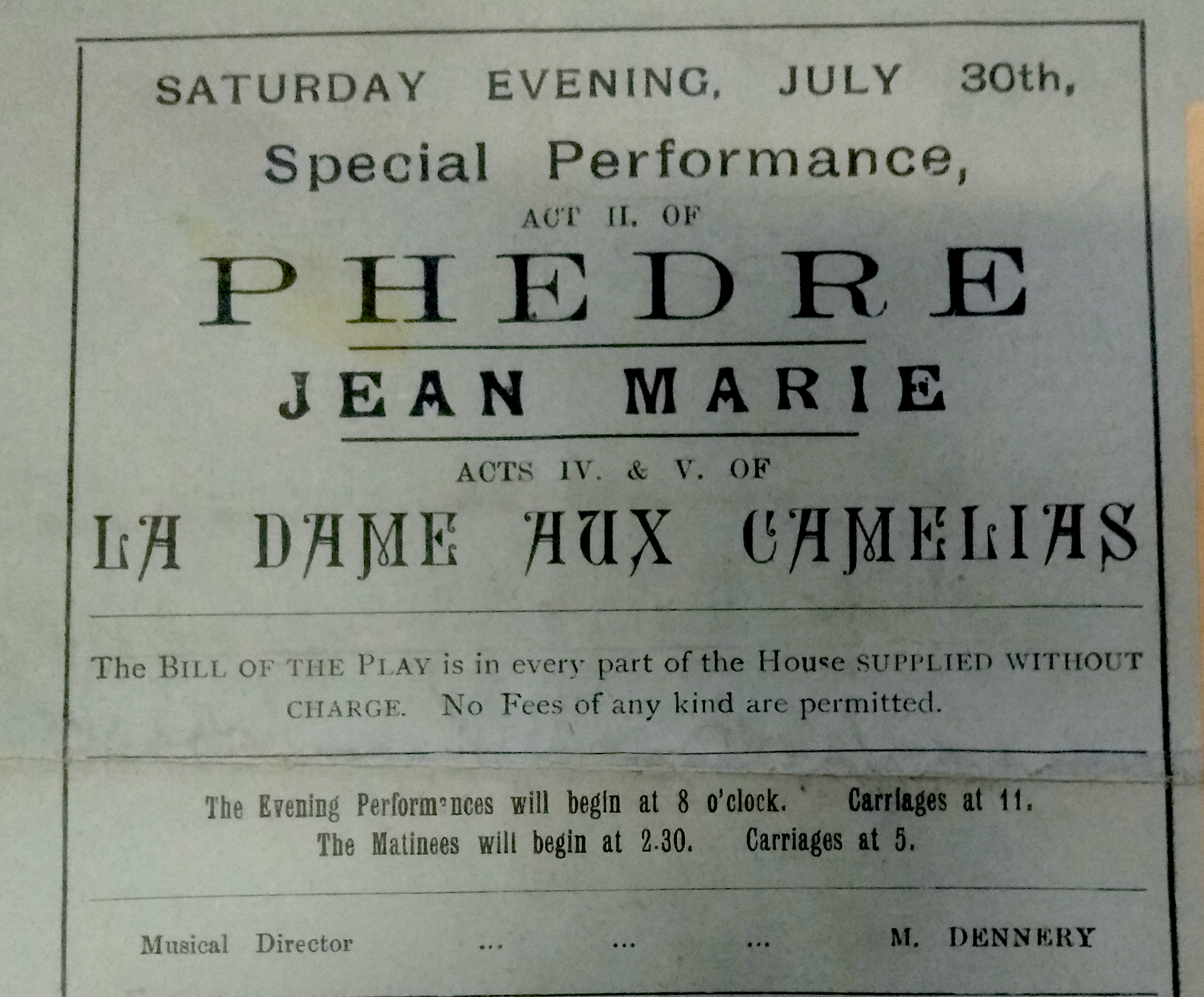
Lyceum Theatre Program, listing Bernhardt in a performance with single acts of her plays, for July 25, 1887. Courtesy of the Victoria and Albert Museum, Theatre and Performance Collection.
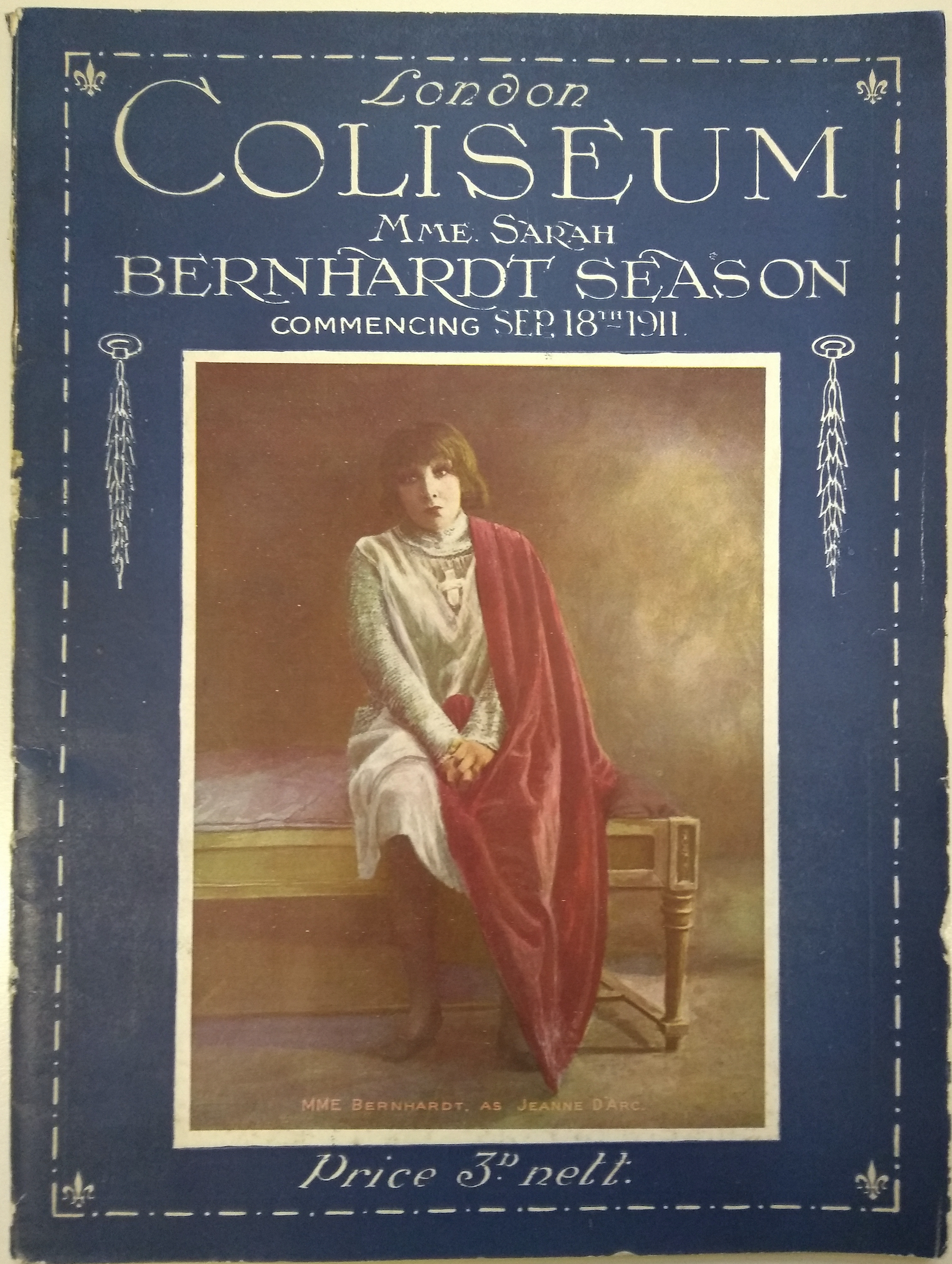
Cover of the Bernhardt Season, London Coliseum, 1911. Courtesy of Special Collections, Exeter University.
The curated fluidity that we can trace between an actress’s movement across legitimate and popular theaters, as well as into early film, indicates that she played an important role in the formation, expansion, and characterization of popular culture in the late nineteenth and early twentieth centuries. Theater scholars such as Jacky Bratton have explored how the making of the West End of London in the mid-nineteenth century (1830-1870) involved the expansion of theaters in the city, as well as female agency at all levels of cultural production. The exuberant theater that Bratton identifies was often authored, managed, performed, and enjoyed by women. When theater actresses later entered silent film, a similar diversity of performance styles and dramatic vehicles expanded their renown, now circulating as products in global film distribution markets. A vital and vibrant group of diverse female actresses circulated on film, expressing coterminous exuberance with the live stage. We might cite, for example, Eleanora Duse and Francesca Bertini from Italy, Asta Nielsen from Denmark, Adriënne Solser from The Netherlands, Sarah Bernhardt, Mistinguett, and Musidora from France, Chrissie Bell and Gladys Sylvani from England, as well as Rosa Porten from Germany.43See Förster, Women in the Silent Cinema, Introduction. See also, for example, Maria Pia Pagani and Paul Fryer, eds., Eleonora Duse and Cenere (Ashes): Centennial Essays (Jefferson, NC: McFarland, 2017); Loiperdinger and Jung, eds., Importing Asta Nielsen; and Jon Burrows, “Girls on film: the musical matrices of film stardom in early British cinema.” Screen, vol. 44, no. 3 (2003): 314-325.
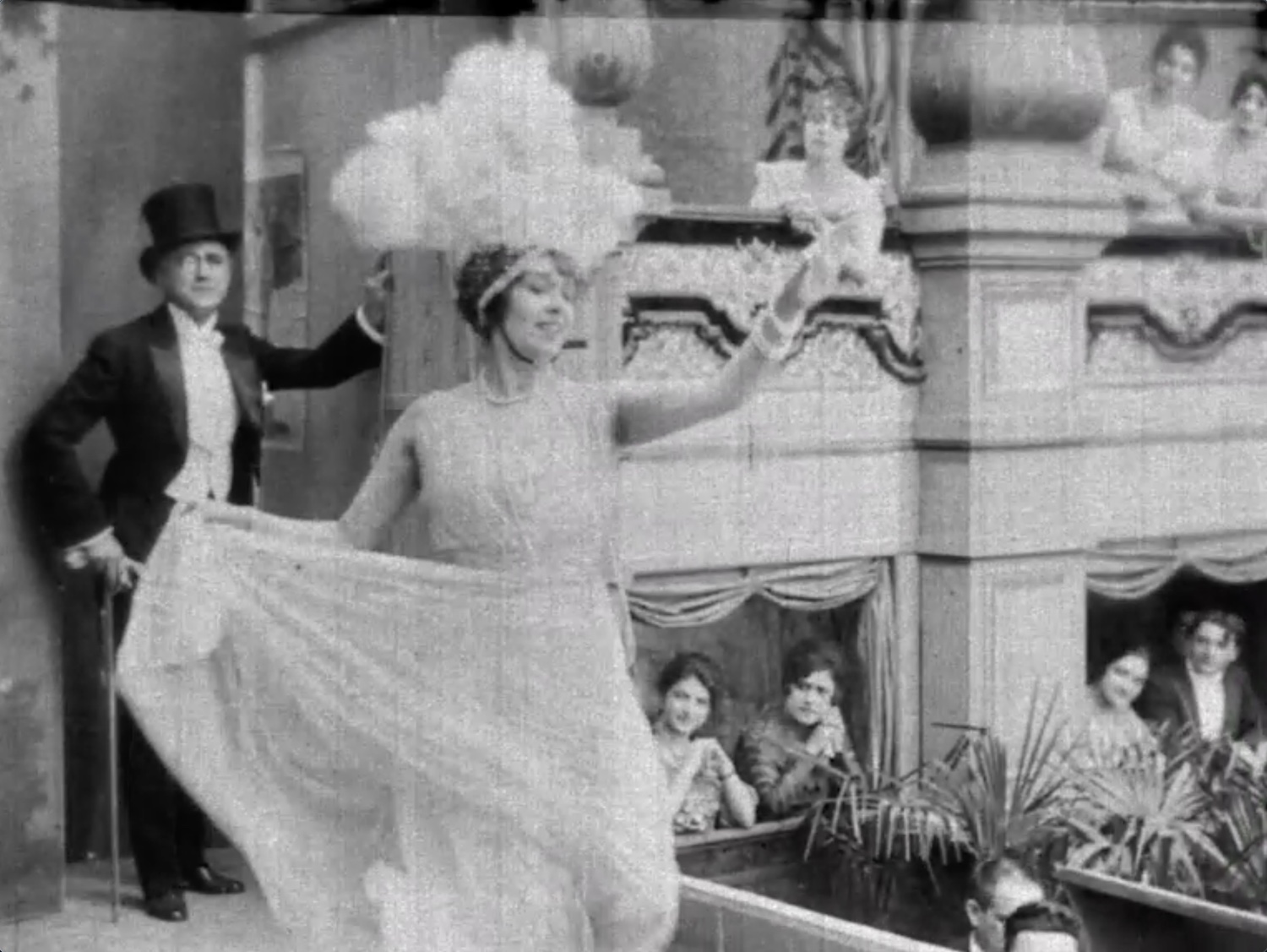
Mistinguett in Fleur de Paris (Flower of Paris, André Hugon, 1916). © LCJ Productions – Collections CNC.
Förster explains that local programming initiatives in variété theaters–known as the music-hall in France and England, vaudeville in America, and Spezialitäten-Programm in Germany–joined short, varied stage performances with film screenings imported from across the world. In this way, the kaleidoscopic joining of the theatre actress and film was also a located event. Actresses such as Solser therefore appeared in the same programs as films. Later, Musidora became renowned in the genre of film that drew from this tradition of the variety program, the ciné-vaudeville, in her collaboration with Louis Feuillade.44Förster, Women in the Silent Screen, 183. In other words, the actress provided her support and skill to a popular and varied entertainment industry that, like the transformations in the West End a generation earlier, helped to transform the nature, scope, and audiences for the theater across the globe.
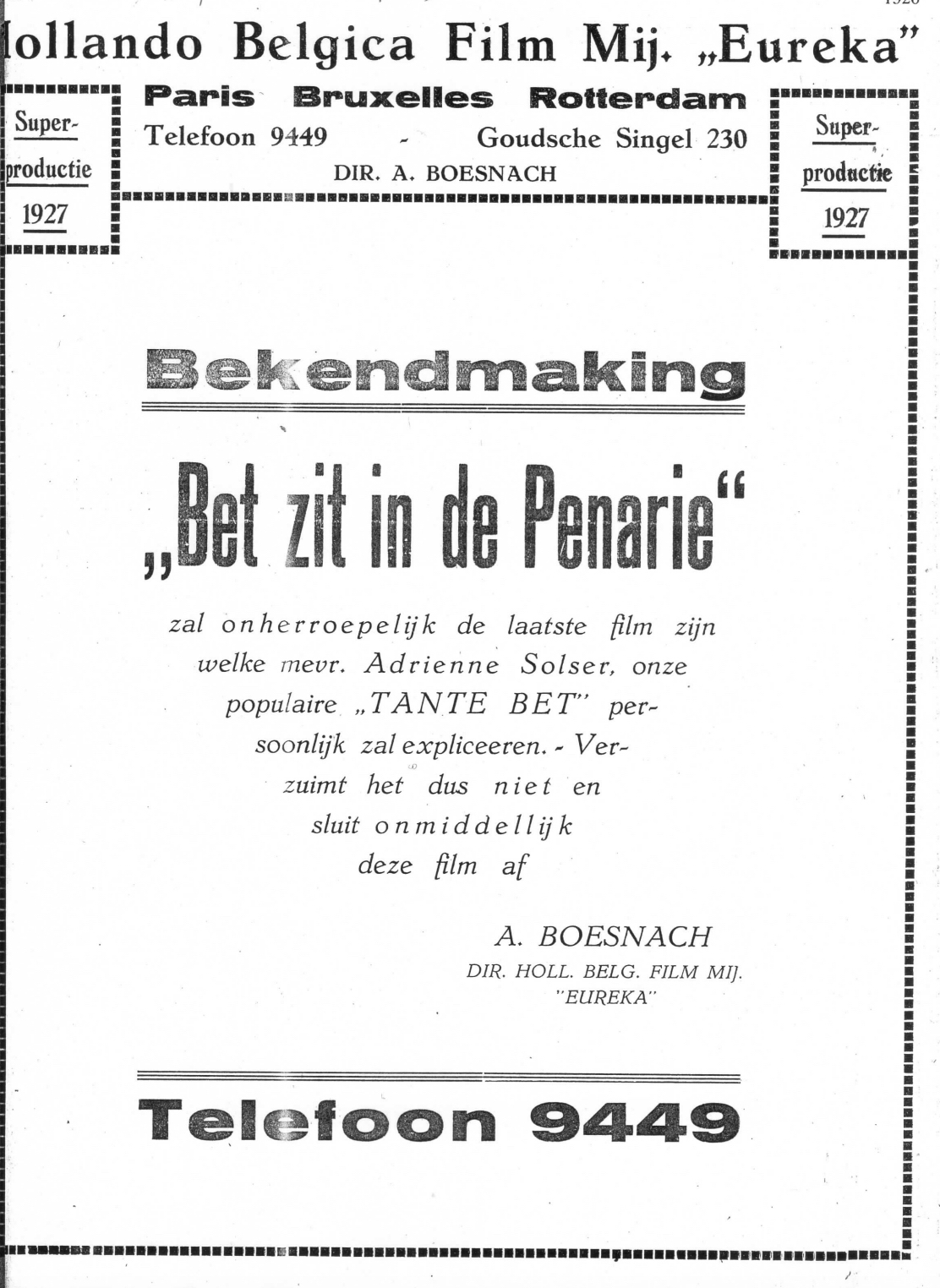
This advertisement reads: “Bet in an awful fix” will irrevocably be the final film with which Mrs. Adrienne Solser, our popular “Tante Bet,” will be lecturing in person. So don’t be too late and book this film immediately.’’ In Nieuw Weekblad voor de Cinematografie vol. 5, no. 13 (24 Dec. 1926): n.p. With thanks to Annette Förster.
At the same time that popular theaters were including film alongside (and even within) live acts on the stage, cinemas offered theatrical performances for their patrons. For example, the world’s largest cinema in the early teens, the 3,400-seat Gaumont-Pathé cinema in Paris, also advertised virtuoso theatrical attractions as part of its film program.45Ibid., 190.As Förster notes, in structuring a film as one would structure an evening at the theatre–the program was divided into two acts, it was presented in a spacious hall, and food and drink were offered during the show–film and theater could also elevate cultural experience.46Ibid., 191 Solser did not disentangle the theater from the cinema even after the First World War, accompanying her films with live appearances in The Netherlands into the 1920s.47Ibid., 80. This practice of mixing recorded and live performance is a feature of our heterogenous performance landscape today.48Note that in discussions of theater training and theatrical shows, the use of screens and videos are often included. See, for instance, Sean McLoughlin’s recent reflection on NIDA (The National Institute of Dramatic Art, Australia) in “Theatre in the age of video: NIDA and TDC reflect on how video has influenced theatre” available at: https://www.aussietheatre.com.au/news/theatre-in-the-age-of-video-nida-and-tdc-reflect-on-how-video-has-influenced-theatre (accessed August 8, 2022).
The importance of the theatrical actress to early film expands well beyond considerations of creative practice. It includes, most pressingly, the awareness that women were at the vanguard of early cinema audiences and constituted a fan base for many actresses on screen. Hilary Hallett’s Go West Young Women!: The Rise of Early Hollywood (2013) demonstrates women’s significant contribution to commercial entertainment in early Hollywood. As Hallett explains: “The reorientation of fan culture toward women during the 1910s was sped by the creeping conviction among many industry insiders that their good fortune demanded catering to the female trade.”49Hallett, Go West Young Women! 23. Rightly noting that this was a strategy adopted from the stage, Hallett highlights how women’s central roles in creating the entertainment landscape of Hollywood put them at the vanguard of the cinematic century that followed.50See also the work of Shelley Stamp in Movie-Struck Girls: Women and Motion Picture Culture After the Nickelodeon (Princeton, NJ: Princeton University Press, 2000) as well as Janet Staiger, “‘The Eyes Are Really the Focus’: Photoplay Acting and Film Form and Style.” Wide Angle vol. 6, no. 4 (1985): 14-23; and Miriam Hansen, Babel and Babylon: Spectatorship in American Silent Film (Cambridge, MA.: Harvard University Press, 1991), particularly Introduction and Chapter 2.
A Cautious Conclusion
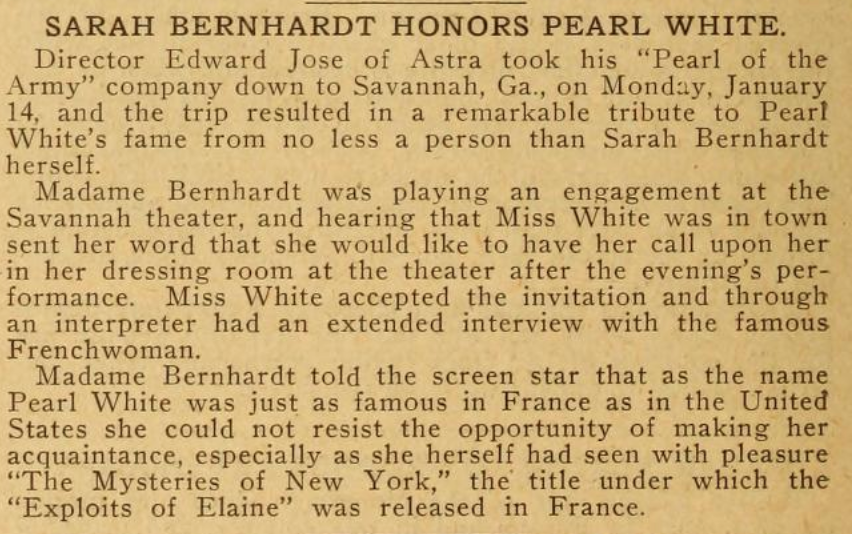
“Sarah Bernhardt Honors Pearl White.” The Moving Picture World, February 1917.
My discussion about the relationship between the late nineteenth century stage actress and early film has been written through the lens of Europe and America. There remains many continents, countries, exchanges, networks, and certainly many stage actresses, who will reveal different histories to us.51See, for inspiration, the programming for the 2022 Women and the Silent Screen conference (New York): https://journals.library.columbia.edu/index.php/silentscreenconference/nycschedule2022 (accessed August 8, 2022). I also thank Jane Gaines for bringing my attention to what she termed “one of the most interesting discoveries” of 2019: early Korean cinema as “combination drama.” See Chonghwa Chung, “How Roleau Became Songsan Instead of Matsuyama: Early Film Practices in Colonial Korea and the Influence from American Serial Films.” Busan International Film Festival, 9 Oct. 2019, http://forum.biff.kr/eng/addon/10000001/page.asp?page_num=2115 (accessed August 8, 2022). Note that the combination drama was made up of two discrete companies: a group of actors who performed the straight play, and a second group of variety performers who added in variety elements. David Mayer was the theater scholar who first linked the combination drama to early film. See David Mayer and Helen-Day Mayer, “A ‘Secondary Action’ or Musical Highlight? Melodic Interludes in Early Film Melodrama Reconsidered.” In The Sounds of Early Cinema, eds. Richard Abel and Rick Altman (Bloomington, IN: Indiana University Press, 2001), 220-331. See also David Mayer’s explanation of the combination system, its emergence as well as its application to early film in Stagestruck Filmmaker, op. cit., 36-40. While I look forward to learning about these theater actresses, I remain aware that even within the broad group of Western countries and continents I discuss, film studies often mistakenly divides older, European theatrical actresses from newer, American or Canadian film actresses of the early twentieth century. Well-known younger actresses–performers such as Pearl White, Blanche Sweet, Mary Pickford, Lillian and Dorothy Gish, Mary Fuller, Florence Lawrence, Florence Turner, and Clara Kimball Young–become representative of the American film actress, and are separated from their European counterparts who incorporated film into their broader managerial and creative repertoires. What is left out of this equation are the ongoing and fertile links between theatre and film, the relationships that were built by actresses of a given generation, as well as the relationships between the actresses of the Old and the New World. A number of these younger actresses also worked as businesswomen, writers, producers, directors and founders of film studios. Rather than pitch differences, I believe that we would do well to cite similarities. It is a significant fact that Bernhardt, Vachel Lindsay’s “tintype” actress, was an innovative game-changer who organized a meeting with Pearl White while on a trip to promote American involvement in the First World War in 1917. These two generations of actresses, mutually aware and respectful of their achievements, were eager to pay tribute to each other. As the French press reported, the two also solidly joined, through the celluloid link, “the country of Washington to the gentle country of Joan of Arc.”52L. Sazie, “La Chaîne de Celluloïd.” Le Cinéma (10 May 1917): 1; See also, “Sarah Bernhardt Honors Pearl White.” The Moving Picture World (10 February 1917): 864.
See also: Sarah Bernhardt, Asta Nielsen, Rosa Porten, Adriënne Solser.

